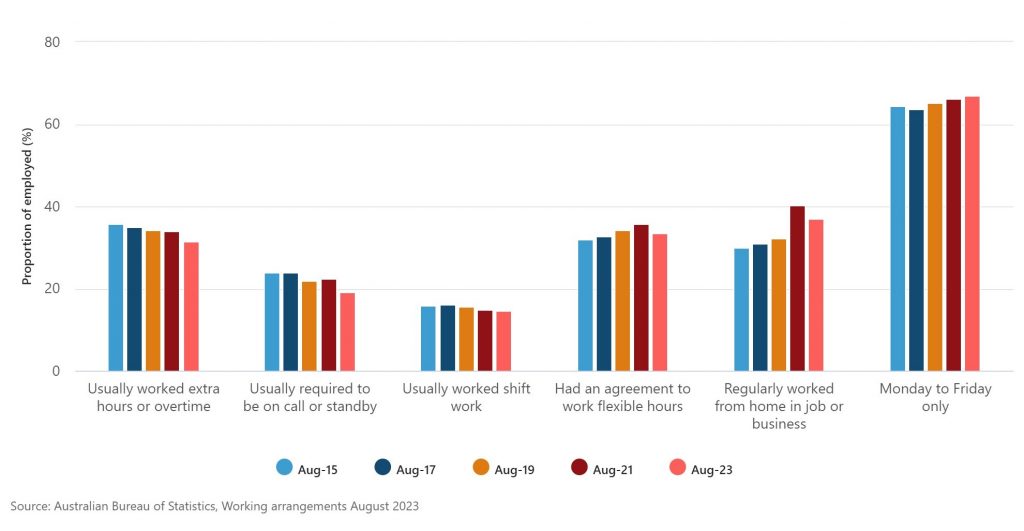Enterprise HR departments have evolved significantly in recent years to keep up with technological advancements and changing work practices. Traditional paper-based processes have become inadequate for the modern work environment, especially with 37% of Australians regularly working from home as of August 2023.
Fully digital, automated and cloud-based systems can help address the complexities of remote and hybrid work models, offering flexibility in scheduling, rostering, and personal preferences. They can enhance efficiency and accuracy, reduce administrative tasks, and minimise human error. In an era where managing employee engagement, goal setting, and performance measurement is both necessary and complex, automated people management systems ensure effective personnel management, regardless of their location.
If your organisation is in the process of refreshing your enterprise HR solution, what features should you look for?
Working arrangements in Australia, August 2023

Automation across key processes
Automated processes decrease procedural delays by completing tasks quicker without sacrificing quality. Your HR department needs automation, especially in payroll and onboarding processes that require accuracy, consistency, efficiency and good governance.
For example, automated payroll can reduce manual calculations (and errors), essential for ensuring compliance with legal and regulatory standards. Automated systems will apply the relevant employment laws to calculations, minimising human error and ensuring that you pay people correctly every time.
Automation in HR not only streamlines operations but also strengthens the integrity and reliability of HR practices. Reducing manual work frees HR professionals from time-consuming tasks, so they can spend more time on the human elements of their jobs.
Integration with core systems
Your HR solutions must integrate with your existing platforms; it is both costly and inefficient if you have to change your scheduling, time and attendance or payroll systems to suit a new core HR solution. Whether you leverage on-prem or cloud platforms, your enterprise HR solution should integrate with your existing set-up.
Integration supports data consistency across the organisation by enabling seamless information flow between departments such as payroll and time and attendance. Integration also becomes particularly important for decision-making because HR leaders can use real-time data to understand areas for improvement or resolve potential issues. It also saves time, money and headaches that arise when information is manually transferred or re-keyed.
A modular approach to deploying capabilities
Scalability and flexibility in HR systems are essential to keep pace with business evolution. Modular capability allows your organisation to select specific HR functions that match your current needs. This flexible approach enables adding or removing modules like recruitment, payroll, or performance management.
Your company can start with basic modules and add more features as the business grows or requires new HR capabilities. This adaptability benefits rapidly growing or changing companies, allowing them to scale their HR needs without major disruptions or costs.
Cloud-based infrastructure
Cloud-based HR solutions like SAP SuccessFactors offer scalability by accommodating business growth and evolving HR needs without extensive infrastructure investment. In Australia, more companies have begun relying on the cloud, with a Gartner survey finding that 62% of Australian CIOs plan to increase their investments in cloud technology this year. HR departments, too, should consider the benefits of moving to the cloud while provisioning modern features that today’s HR teams need.
Cloud infrastructure provides HR with increased flexibility, accessibility, and security. It allows the business to adjust HR capabilities with growth and changes, supports remote access for a mobile workforce, and includes basic security measures to protect sensitive data.
Self-service to boost accessibility
Self-service modules allow employees to manage requests and personal information independently. Rather than emailing or messaging HR, they can access employment details, benefits, and payroll, reducing the need for disparate, back-and-forth communication. Self-service also allows people to access real-time data, such as leave balances, pay slips, and personal details. This shift reduces the administrative load on HR, allowing them to focus on strategic initiatives.
Data-driven insights for decision-making
Data-driven insights offer a factual base for decision-making. Your enterprise HR solution should provide insights from employee data to help understand workforce trends, predict needs, and pinpoint improvement areas. Shifting from intuition to data-driven strategies leads to more informed and effective HR decisions.
HR solutions track metrics like performance, retention, and recruitment efficiency, aiding in informed decisions about talent management and resource allocation. Such data can also inform long-term strategies such as succession planning and workforce development. Understanding trends and forecasting changes allows proactive workforce management that aligns HR strategies with business goals.
Conclusion
When selecting an enterprise HR solution, you should prioritise features that align with your company’s unique needs and goals. Automation can greatly enhance HR processes such as payroll and onboarding. Additionally, integration with your current platforms ensures you do not have to replace existing systems and information remains consistent across the organisation.
Self-service modules are another ideal feature to consider. Your organisation can significantly increase employee satisfaction by enabling people to manage schedules, update personal details and view information from any location on the device of their choice. Cloud-based infrastructure enables flexibility and scalability; a modular platform complements this capability by enabling the organisation to adjust capabilities as needed.
Why choose an enterprise HR solution from Tambla?
At Tambla, we understand the complexities of modern HR management and the need for tailored solutions that enhance employee experience and retention. Our expertise in deploying and managing SAP SuccessFactors allows your business to simplify processes and make informed decisions quickly. We’re committed to streamlining your HR strategies, ensuring decision-making and engagement are at the forefront of your HR solutions.
If you are in the process of enhancing your HR systems, let Tambla guide you. We offer a range of services, from system deployment and implementation to comprehensive managed services designed to provide efficient and reliable HCM software. Visit our Enterprise HR & HCM Solutions page for more information.
Related blogs
Why payroll compliance is a non-negotiable for all companies
5 workforce planning challenges experienced in Container Port Operations
How time and attendance software supports workforce compliance





